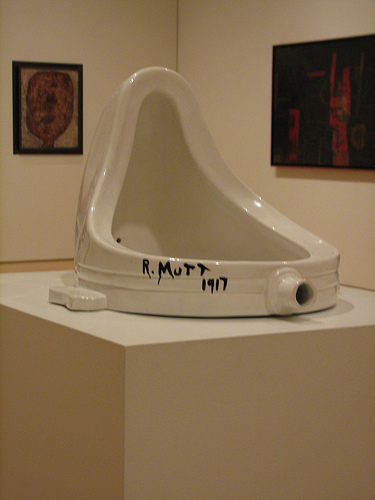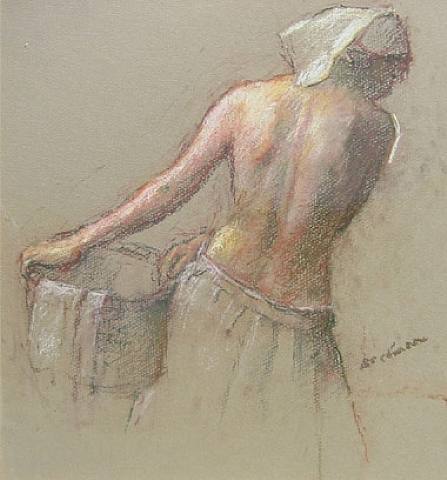Duchamp vs Brackman
One can get a sense of the direction painting has taken by comparing early 20th century artists Marcel Duchamp, born in France, with Robert Brackman, born in the Ukraine. (Brackman, as many of you know, immigrated to the US and was my teacher’s teacher.) A story I often tell of Brackman, through whom our method passes, is that he spent seven years doing nothing but underpaintings. A serious student was he to be sure. Duchamp, we are told, essentially became bored with painting, preferred applying himself to chess, but not before he decided, in effect, to play games with the art cognoscenti, of whom he was the proverbial darling and advisor. Duchamp, as you know, contributed to human achievement in art by exhibiting such “ready-mades” as the snow shovel (exactly like the one you would buy in a store) and, perhaps more famously, an ordinary urinal, dubbed The Fountain in 1917.


Duchamp Brackman
Art, as various agents and critics have reminded us, must be incomprehensible to the average Joe in order that it confer the status of intelligentsia onto those in the know and pay dividends to those willing and able to pay hard cold cash for historically significant art pieces, like The Fountain. (Is anyone noticing the circularity here?) Thus in 1998, Mike Bilbo, perhaps best described as an entrepreneurial artist, drew 4,000 versions of Duchamp’s famous urinal and sold $100,000 worth of his drawings. “Rocketing prices for replicas, editions and even the most fleeting ephemeral trace of Marcel Duchamp reached a pinnacle of absurdity,” noted art historian Alice Goldfarb Marquis, “with the sale of a replica of The Fountain from an edition of eight, at Sotherby’s in November 1999, for 1.7 million dollars.”[1]
Duchamp, as either genius or pawn, remains a central figure in 20th century visual art. Again Marquis: “Duchamp opened the door – even the museum door – to art featuring feces, urine, and other bodily fluids; to art based on junk recovered from the city dump; to art involving cadavers and maggots; and to art with aggressively sexual themes. Artists who display their own naked or provocatively clothed bodies may also point to Duchamp. In short, the avant-garde art of the late twentieth century flaunts impropriety, defiance, messiness, and snickering disdain for the vast majority of museum-goers.” [2]
While I greatly admire Brackman’s work, it doesn’t “send” me. His subject matter and compositions seem too traditional, even old fashion in a way. More importantly for my taste, he carried his paintings too far. They appear too finished. This is especially true if one only sees his work through old reproductions. However, I have seen his work in person and in person one can feel the emotion that his complexity of color and finesse of line exude. His sense of tonality is positively haunting especially in his pastel drawings, as in the one above. And I have seen work of his that was “unfinished,” where the verve or “glamour,” as he would call it, jumps off the canvas. When he was 86 a student said to him that he (the student) noticed more color in his work; Brackman’s response was that this was because he (at 86) was beginning to see more color. No clever stunts. No success by scandal. And, a bored painter he was not.
One of his greatest strengths was also that of an inspiring teacher. Like Robert Henri, with whom he studied, he understood the painting process as well as the spirit of art and used concision, drama, and wit to get students to understand. I used to hear my teacher recount endless studio stories that both informed and made you laugh. This one, which is more about Brackman’s temperament, is instructive nonetheless:
One morning Brackman received a call in his Connecticut studio. “Hello, Mr. Brackman. I’m Peter Worthington. You may not remember me but I studied with you many years ago. And I have a favor to ask – and, of course, I will be happy to compensate you for your time.”
“You see,” Worthington continued, “I’ve just been appointed first violinist of the Boston Symphony and tonight my friends are throwing me a party. And I was thinking how interesting it would be if I could do a little still life of my violin and have it there as part of a musical tableau for tonight’s party. Now – I remember that you used to break the painting process down into stages and I was wondering if you could walk me through the stages, once more, over the phone.”
Brackman replied: “Well Mr. Worthington, in fact, I do remember you and it is so ironic that you should call at this very moment. You see, tonight my friends are also giving me a party and just before you called, I was thinking how nice it would be if by tonight I could play – oh, let’s see – Brahm’s Violin Concerto. Could you please walk me through that over the phone?”
“I don’t think that is very funny Mr. Brackman.”
“Neither do I.”
CLICK!!
I saw this diagram one time where the history of painting was presented as a tree with all these branches first emerging from a trunk and then from one another suggesting that one art movement begot another and so on. Duchamp was a major branch, of course, with all these smaller branches coming out of it. Interestingly, Brackman was considered important enough to be one of the branches too; but he was represented as one of the dead ends, a branch that virtually no one takes any more. Pretty accurate diagram, actually.
1 Comment
Address
Via Teresio Olivelli, 20
22021 Bellagio (CO)
Italy
+39 338 975 7135
Open Hours
Tuesday - Saturday: 11:00am – 6:00pm
Sunday - Monday: 1:00pm – 6:00pm

I’m glad that you “went there.”
Hilarious story, too…